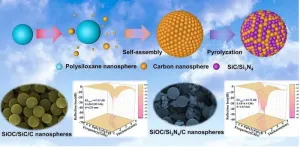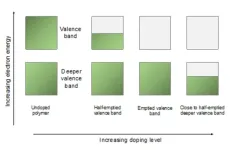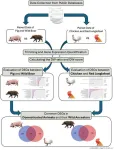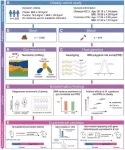(Press-News.org) Why does the universe contain matter and (virtually) no antimatter? The BASE international research collaboration at the European Organisation for Nuclear Research (CERN) in Geneva, headed by Professor Dr Stefan Ulmer from Heinrich Heine University Düsseldorf (HHU), has achieved an experimental breakthrough in this context. It can contribute to measuring the mass and magnetic moment of antiprotons more precisely than ever before – and thus identify possible matter-antimatter asymmetries. BASE has developed a trap, which can cool individual antiprotons much more rapidly than in the past, as the researchers now explain in the scientific journal Physical Review Letters.
After the Big Bang more than 13 billion years ago, the universe was full of high-energy radiation, which constantly generated pairs of matter and antimatter particles such as protons and antiprotons. When such a pair collides, the particles are annihilated and converted into pure energy again. So, all in all, exactly the same quantities of matter and antimatter should be generated and annihilated again, meaning that the universe should be largely matterless as a consequence.
However, there is clearly an imbalance – an asymmetry – as material objects do exist. A minuscule amount more matter than antimatter has been generated – which contradicts the standard model of particle physics. Physicists have therefore been seeking to expand the standard model for decades. To this end, they also need extremely precise measurements of fundamental physical parameters.
This is the starting point for the BASE collaboration (“Baryon Antibaryon Symmetry Experiment”). It involves the universities in Düsseldorf, Hanover, Heidelberg, Mainz and Tokyo, the Swiss Federal Institute of Technology in Zurich and the research facilities at CERN in Geneva, the GSI Helmholtz Centre in Darmstadt, the Max Planck Institute for Nuclear Physics in Heidelberg, the National Metrology Institute of Germany (PTB) in Braunschweig and RIKEN in Wako/Japan.
“The central question we are seeking to answer is: Do matter particles and their corresponding antimatter particles weigh exactly the same and do they have exactly the same magnetic moments, or are there minuscule differences?” explains Professor Stefan Ulmer, spokesperson of BASE. He is a professor at the Institute for Experimental Physics at HHU and also conducts research at CERN and RIKEN.
The physicists want to take extremely high resolution measurements of the so-called spin-flip – quantum transitions of the proton spin – for individual, ultra-cold and thus extremely low-energy antiprotons; i.e. the change in orientation of the spin of the proton. “From the measured transition frequencies, we can, among other things, determine the magnetic moment of the antiprotons – their minute internal bar magnets, so to speak,” explains Ulmer, adding: “The aim is to see with an unprecedented level of accuracy whether these bar magnets in protons and antiprotons have the same strength.”
Preparing individual antiprotons for the measurements in a way that enables such levels of accuracy to be achieved is an extremely time-consuming experimental task. The BASE collaboration has now taken a decisive step forward in this regard.
Dr Barbara Maria Latacz from CERN and lead author of the study that has now been published as an “editor’s suggestion” in Physical Review Letters, says: “We need antiprotons with a maximum temperature of 200 mK, i.e. extremely cold particles. This is the only way to differentiate between various spin quantum states. With previous techniques, it took 15 hours to cool antiprotons, which we obtain from the CERN accelerator complex, to this temperature. Our new cooling method shortens this period to eight minutes.”
The researchers achieved this by combining two so-called Penning traps into a single device, a “Maxwell’s daemon cooling double trap”. This trap makes it possible to prepare solely the coldest antiprotons on a targeted basis and use them for the subsequent spin-flip measurement; warmer particles are rejected. This eliminates the time needed to cool the warmer antiprotons.
The significantly shorter cooling time is needed to obtain the required measurement statistics in a significantly shorter period of time so that measuring uncertainties can be reduced further. Latacz: “We need at least 1,000 individual measurement cycles. With our new trap, we need a measurement time of around one month for this – compared with almost ten years using the old technique, which would be impossible to realise experimentally.”
Ulmer: “With the BASE trap, we have already been able to measure that the magnetic moments of protons and antiprotons differ by max. one billionth – we are talking about 10-9. We have been able to improve the error rate of the spin identification by more than a factor of 1,000. In the next measurement campaign, we are hoping to improve magnetic moment accuracy to 10-10.”
Professor Ulmer on plans for the future: “We want to construct a mobile particle trap, which we can use to transport antiprotons generated at CERN in Geneva to a new laboratory at HHU. This is set up in such a way that we can hope to improve the accuracy of measurements by at least a further factor of 10.”
Background: Traps for fundamental particles
Traps can store individual electrically charged fundamental particles, their antiparticles or even atomic nuclei for long periods of time using magnetic and electric fields. Storage periods of over ten years are possible. Targeted particle measurements can then be made in the traps.
There are two basic types of construction: So-called Paul traps (developed by the German physicist Wolfgang Paul in the 1950s) use alternating electric fields to hold particles. The “Penning traps” developed by Hans G. Dehmelt use a homogeneous magnetic field and an electrostatic quadrupole field. Both physicists received the Nobel Prize for their developments in 1989.
Original publication:
B. M. Latacz, M. Fleck, J. I. Jäger, G. Umbrazunas, B. P. Arndt, S. R. Erlewein, E. J. Wursten, J. A. Devlin, P. Micke, F. Abbass, D. Schweitzer, M. Wiesinger, C. Will, H. Yildiz, K. Blaum, Y. Matsuda, A. Mooser, C. Ospelkaus, C. Smorra, A. Soter, W. Quint, J. Walz, Y. Yamazaki, and S. Ulmer. Orders of Magnitude Improved Cyclotron-Mode Cooling for Non-Destructive Spin Quantum Transition Spectroscopy with Single Trapped Antiprotons, Physical Review Letters 133, 053201 (2024).
DOI: 10.1103/PhysRevLett.133.053201
END
Cold antimatter for quantum state-resolved precision measurements
Physics: Publication in Physical Review Letters
2024-08-02
ELSE PRESS RELEASES FROM THIS DATE:
Smart aggregates: The future of infrastructure health monitoring
2024-08-02
The proliferation of concrete infrastructure worldwide has been met with growing concerns over its durability and safety. Concrete structures are increasingly subjected to dynamic forces from natural disasters like earthquakes and environmental degradation, such as corrosion. These factors, coupled with the saturation of infrastructure projects, amplify the risks associated with structural failure. Consequently, there is a pressing need for effective structural health monitoring (SHM) systems that can preemptively identify and address these vulnerabilities. The ...
Synthesis of SiOC@C ceramic nanospheres with tunable electromagnetic wave absorption performance
2024-08-02
In recent years, microwave technology has dramatically progressed, marked by the arrival of the 5G era, owing to the advantages of electromagnetic waves in long-distance, wireless, and high-speed transmissions. However, electromagnetic wave pollution problems such as electromagnetic wave interference and electromagnetic wave radiation are becoming increasingly serious. Electromagnetic wave pollution not only affects the normal operation of electronic equipment, greatly threatens the information security of the scientific community, but also endangers human health and is a possible cause of cancer ...
NWSL add lifesavers to the chain of survival in New York City
2024-08-02
NEW YORK CITY, August 2, 2024 — According to American Heart Association data, nine out of every ten people who experience cardiac arrest outside of a hospital die, in part because they do not receive immediate CPR more than half of the time. CPR, especially if performed immediately, can double or triple a person’s chance of survival. That is why the American Heart Association and the National Women’s Soccer League (NWSL) brought cardiopulmonary resuscitation (CPR) and automated external defibrillator (AED) training to NWSL staff at the New York headquarters office located on Madison ...
Solving the doping problem: Enhancing performance in Organic Semiconductors
2024-08-02
Cavendish physicists have discovered two new ways to improve organic semiconductors. They found a way to remove more electrons from the material than previously possible and used unexpected properties in an environment known as the non-equilibrium state, boosting its performance for use in electronic devices.
“We really wanted to hit the nail and figure out what is happening when you heavily dope polymer semiconductors,’ said Dr Dionisius Tjhe, Postdoctoral Research Associate at the Cavendish Laboratory. Doping is the process of removing or adding electrons into a semiconductor, increasing its ability to ...
More pets relinquished to shelters due to housing insecurity
2024-08-02
Housing policies may be becoming more pet inclusive, but housing insecurity is getting worse, finds a new study that examined the housing issues that led to owners turning their pets over to an animal shelter.
“Over the duration of the study, instances of animals entering shelters due to loss of housing rose, while those due to pet restrictions and landlord conflicts declined,” said the study’s lead author Jennifer Applebaum, Ph.D., an assistant professor in the Department of Environmental and Global Health in the University ...
KTU researchers’ eye-tracking study provides valuable insights into learning mathematics
2024-08-02
Eye-tracking allows studying aspects that cannot be seen, for example, the thinking processes of a student solving a mathematical problem. Researchers at Kaunas University of Technology (KTU) are the first in Lithuania to integrate eye-tracking into education and are using the technology to radically improve the teaching of mathematics.
Eye-tracking creates the possibility for researchers to observe a subject’s attention shifts based on where they fix their gaze or how they move it. This helps researchers understand various emotional, thinking and cognitive processes that happen in response to the environment.
“By applying this technology in mathematical education, ...
New approaches and insights on the environment and climate change at the 37th International Geological Congress 2024
2024-08-02
□ Overview
○ Event: The 37th International Geological Congress 2024 (IGC 2024)
○ Date/Venue:: 25 Aug (Sun) - 31 Aug (Sat) 2024, 7 days / BEXCO, Busan, Republic of Korea ※ Hosted in a 4-year cycle across continents
○ Scale: Over 7,000 participants from 121 countries (more than 3,000 scientipic programs, 250 exhibition booths)
○ Theme: The Great Travelers: Voyages to the Unifying Earth
○ Host: International Union of Geologcial Sciences (IUGS)
○ Organizer: IGC 2024 Organizing Committee (The Geological Society Of Korea, Korea Institute of Geoscience and Mineral Resources, Busan Metropolitan ...
Genetic signatures of domestication identified in pigs, chickens
2024-08-02
Wild boars and red junglefowl gave rise to common pigs and chickens. These animals’ genes evolved to express themselves differently, leading to signatures of domestication — such as weaker bones and better viral resistance — in pigs and chickens, according to a research team based in Japan.
The findings, published on July 6 in Animals, could provide insight into the genetic changes of the domestication process and highlight target genes for healthier and more productive livestock breeding, the researchers ...
Megamonas bacterium found to influence obesity risk
2024-08-02
A recent study published in Cell Host & Microbe identifies a potential obesity-linked bacterium, Megamonas, from a large-scale cohort of obese individuals in China. This research suggests potential strategies for future obesity management by illustrating how the bacterium degrades intestinal myo-inositol, enhances lipid absorption, and contributes to obesity.
The study is jointly conducted by Ruijin Hospital affiliated with Shanghai Jiao Tong University School of Medicine, BGI Research, and BGI Genomics Institute of Intelligent Medical Research (IIMR).
"Through a large-scale study of intestinal ...
Scientists find a human “fingerprint” in the upper troposphere’s increasing ozone
2024-08-02
Ozone can be an agent of good or harm, depending on where you find it in the atmosphere. Way up in the stratosphere, the colorless gas shields the Earth from the sun’s harsh ultraviolet rays. But closer to the ground, ozone is a harmful air pollutant that can trigger chronic health problems including chest pain, difficulty breathing, and impaired lung function.
And somewhere in between, in the upper troposphere — the layer of the atmosphere just below the stratosphere, where most aircraft cruise — ozone contributes to warming the planet as a potent greenhouse gas.
There are signs that ozone is continuing to rise in the upper troposphere despite efforts to reduce its ...
LAST 30 PRESS RELEASES:
For teens, any cannabis use may have impact on emotional health, academic performance
School meals could unlock major gains for human and planetary health
Menopause hormone therapy does not appear to impact dementia risk
Signature patterns of brain activity may help predict recovery from traumatic brain injury
Dresden study uncovers new key mechanism in cancer cells
New species are now being discovered faster than ever before, study suggests
Cannabis-based products show limited short-term benefit for chronic pain, with increased risk of adverse effects
Cannabis products with more THC slightly reduce pain but cause more side effects
Clearing the brain of aging cells could aid epilepsy and reduce seizures
Brain injuries linked with potential risk of suicide, new study finds
New technique lights up where drugs go in the body, cell by cell
New study finds movement of fishing fleets can reveal shifts in marine ecosystems
Embargoed: New evidence points to potential treatment for vascular dementia
Study uncovers disrupted brain balance in alcohol dependence
Working in groups can help Republicans and Democrats agree on controversial content moderation online
Structural findings reveal how distinct GPCR ligands create different levels of activation
Anything-goes “anyons” may be at the root of surprising quantum experiments
UC review: Maximizing workplace opportunity for veterans
From generation to complex control: Metasurfaces make perfect vortex beams "within reach"
Thin-film lithium niobate-based detector: recent advances and perspectives
Exploring why some people may tend to persistently make bad choices
How cells balance their protein levels
Nirsevimab vs RSVpreF vaccine for RSV–related hospitalization in newborns
Effectiveness and impact of maternal RSV immunization and nirsevimab on medically attended RSV in US children
AI gives scientists a boost, but at the cost of too many mediocre papers
Next-generation vision model maps tree growth at sub-meter precision
Genes aren’t destiny for inherited blindness, study shows
MIT study: High-fat diets make liver cells more likely to become cancerous
Exposure to multiple fine particulate matter components and incident depression in the US Medicare population
Risk of burdensome health care spending over time in the US
[Press-News.org] Cold antimatter for quantum state-resolved precision measurementsPhysics: Publication in Physical Review Letters








